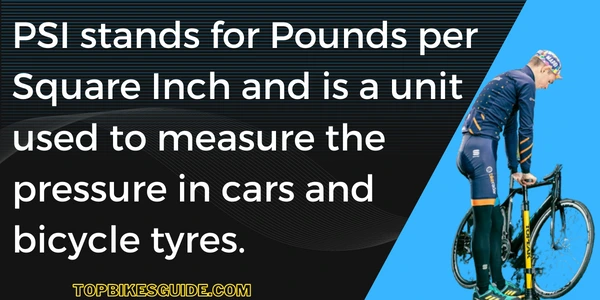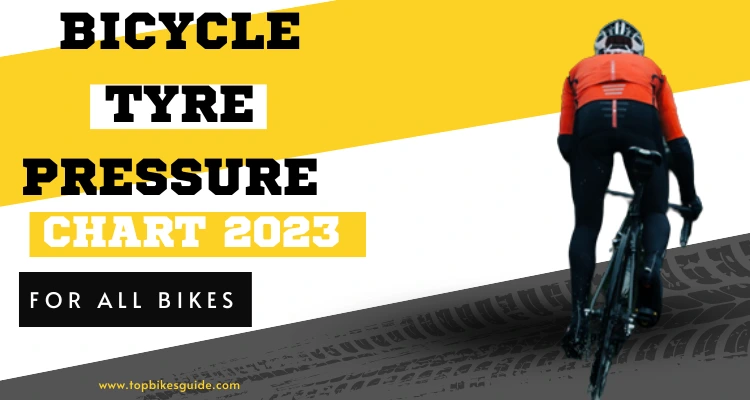Bicycling is a healthy and eco-friendly way to navigate the city. Maintaining proper tyre pressure is crucial to ensure safety and a smooth ride. Use our bicycle tyre pressure chart as a guide for recommended pressure levels. You can ride confidently and enjoy your cycling experience with the proper tyre pressure.
Why is It Important to Have Perfect Tyre Pressure?
Having the perfect tyre pressure is crucial for several reasons. It enhances safety by maximizing contact with the road and improving bike control. Additionally, it improves your riding experience by creating a smoother ride with less effort. Moreover, maintaining the correct tyre pressure extends your bike’s lifespan by minimizing wear and tear. In summary, proper tyre pressure significantly impacts your cycling experience.
Regular checking and maintaining proper tyre pressure is crucial for optimal performance during your ride. This is particularly important for mountain and electric bicycles requiring higher pressure levels. Refer to our bicycle tyre pressure chart for recommended levels. You’ll enjoy safe and comfortable rides for years with the correct maintenance and adequate air pressure.
Perfect tyre pressure is essential for getting the most out of your bike. By using our bicycle tyre pressure chart as a guide and regularly checking the air levels in your tyres, you can ensure you’re riding with optimal performance and safety.
What is PSI?
PSI stands for Pounds per Square Inch and is a unit used to measure the pressure in cars and bicycle tyres. This measurement indicates how much force is applied over a given area, usually expressed as pounds-force per square inch (psi).
When adjusting tire pressure, it’s crucial to consider that PSI varies between bike types. To optimize performance and safety, check the manufacturer’s recommended air pressure levels for your specific bike. Mountain bikes require higher pressures for improved grip on uneven terrain, while electric bicycles typically need higher PSI due to their heavier weight. Always follow the suggested PSI value from the manufacturer for accurate adjustments.

Regularly checking and maintaining your bike’s tyre pressure is crucial for optimal performance, safety, and extending tyre lifespan. Use a bicycle tyre pressure chart to guide, ensuring the suitable PSI. Remember to check the pressure when the tyres are cold for accurate readings. With regular maintenance, your bike will always perform at its best.
Benefits Of Maintaining Perfect Tyre Pressure
Regularly maintaining the correct tyre pressure for your bicycle can be a great way to ensure a smooth and safe ride.
- Improved Fuel Efficiency: Maintaining the correct tyre pressure on your bicycle can help improve fuel efficiency and reduce the energy needed to power your ride. Regularly checking the pressure level of your tyres ensures that you can keep your bike running at its best and maximize your fuel efficiency.
- Enhanced Safety: Ensuring your bicycle tyres are inflated to the correct pressure is essential for safety and performance. Not only will it help you maintain control of your bike, but it will also help you to avoid punctures and other tyre-related issues.
- Reduced Wear and Tear on Your Tyres: Maintaining the correct tyre pressure on your bicycle can help reduce wear and tear on your tyres, especially when riding on rough road surfaces. Properly inflated tyres improve grip and traction, resulting in fewer flat tyres and a longer lifespan.
- Increased Vehicle Performance: Increasing the tyre pressure of a bicycle is an effective way to improve its performance and efficiency. When selecting the correct tyre pressure for your bike, it is crucial to consider factors such as terrain, rider weight, and type of tyre. A tyre pressure chart can be a helpful tool in determining the optimal tyre pressure for your bicycle.
- Reduced Carbon Emissions: Paragraph: Pumping up your bike tires to the correct pressure can significantly impact your bike’s performance and reduce your carbon footprint. Not only will you be able to ride faster and further, but you will also be helping to reduce your emissions of harmful greenhouse gases.
Bicycle Tyre Pressure Chart For Various Types of Bikes
| Bike Type | Recommended PSI Range |
| Road Bike | 80-130 PSI |
| Mountain Bike | 25-35 PSI |
| Cruiser | 40-50 PSI |
| BMX Bike | 20-40 PSI |
| Fat Tire Bike | 15-25 PSI |
| Electric Bike | 25-60 PSI |
| Hybrid Bike | 40-70 PSI |
| Touring Bike | 90-130 PSI |
| Cyclocross Bike | 40-60 PSI |
| Folding Bike | 60-100 PSI |
| Tandem Bike | 40-70 PSI |
| Kids Bike | 20-40 PSI |
How to Achieve the Perfect Tyre Pressure on Your Bicycle?
To achieve the perfect tyre pressure on your bicycle, it is crucial to consider factors such as terrain, rider weight, and type of tyre. Additionally, using a bike tyre pressure chart can help you find the ideal PSI range for your bike. Finally, use a quality pump or air compressor to measure and adjust your tyre pressure accurately.
- Hybrid Bikes: Hybrid bikes typically require a tyre pressure between 40-70 PSI, depending on the weight and terrain of the rider. When selecting the correct tyre pressure for your hybrid bike, refer to a bike tyre pressure chart or consult your manufacturer’s recommendations.
- Mountain Bikes: Mountain bikes typically require a lower tyre pressure (25-35 PSI) than other bikes due to the softer terrain and obstacles they encounter. Riders should refer to a bike tyre pressure chart or consult their manufacturer’s recommendations to determine the optimal PSI for their mountain bike. Additionally, riders can experiment with different pressures to find the best ride.
- Road Bikes: Road bikes usually require a higher tyre pressure (80-130 PSI) than other bikes due to the tricky terrain and travel speeds. To determine the correct tyre pressure for your road bike, refer to a bike tyre pressure chart or consult your manufacturer’s recommendations. Additionally, riders should consider their weight and terrain when selecting the correct PSI for their road bike.
How often should you check your bicycle’s tyre pressure?
You should check your bicycle’s tyre pressure regularly, especially before long rides. You should also check the pressure after any significant changes in temperature or terrain. It is best to use a quality pump or air compressor and refer to a bike tyre pressure chart to measure and adjust the PSI of your tyres accurately.
It is important to remember that different tyre pressures are required for varying terrains and rider weights, so make sure to adjust your tyre pressure accordingly. Regularly checking and adjusting your bicycle’s tyre pressure will help ensure a safe and comfortable ride.
Conclusion
It is essential to maintain the perfect tyre pressure on your bicycle for a variety of reasons. Doing so can improve fuel efficiency, enhance safety, reduce wear and tear on your tyres, increase vehicle performance, and reduce carbon emissions. The ideal tyre pressure for your bicycle depends on the type of bike you own, and it is recommended that you check your tyre pressure at least once a month. By following these steps, you can ensure your bicycle is always running at its best.
FAQs
What PSI should my bicycle tyres be?
The ideal tyre pressure for your bicycle will depend on your bike type. It is recommended to check the manufacturer’s instructions or the sidewall of your tyre for specific PSI recommendations and periodically check with a reliable pressure gauge. Generally, road bikes should be inflated between 85-130 psi and hybrid/mountain bikes should be between 40-60 psi.
What is the tire pressure for a 26-inch bike?
The ideal tyre pressure for a 26-inch bike will vary depending on the type of bike. Generally, road bikes should be inflated between 85-130 psi and hybrid/mountain bikes should be between 40-60 psi. It is recommended to check the manufacturer’s instructions or the sidewall of your tyre for specific PSI recommendations.
What is the bar pressure for a bike?
The bar pressure of a bike tyre depends on the type of bike. Generally, road bikes should be inflated between 6-9 bar and hybrid/mountain bikes should be between 2.5-4.0 bar. It is recommended to check the manufacturer’s instructions or the sidewall of your tyre for specific pressure recommendations.
What pressure should a 20-inch bicycle wheel be?
The ideal tyre pressure for a 20-inch bicycle wheel will vary depending on the type of bike. Generally, road bikes should be inflated between 85-130 psi and hybrid/mountain bikes should be between 40-60 psi. It is recommended to check the manufacturer’s instructions or the sidewall of your tyre for specific PSI recommendations.
Is 40 psi OK for bike tires?
Yes, 40 psi is generally acceptable for bike tires. This is the recommended pressure range for hybrid/mountain bikes, although it’s still essential to check the manufacturer’s instructions or the sidewall of your tyre for specific PSI recommendations. Regularly check your tyres with a reliable pressure gauge to ensure they’re correctly inflated.
Is 40 psi good bike tire pressure?
Yes, 40 psi is generally considered a good tire pressure for hybrid/mountain bikes. However, it’s always a good idea to check the manufacturer’s instructions or the sidewall of your tyre for specific PSI recommendations, as this can vary depending on the type of bike.
What is the tire pressure for a 27-inch bike?
The ideal tyre pressure for a 27-inch bike will depend on the type of bike. Generally, road bikes should be inflated between 85-130 psi and hybrid/mountain bikes should be between 40-60 psi. It is recommended to check the manufacturer’s instructions or the sidewall of your tyre for specific PSI recommendations.
Is 26 tire pressure safe?
Yes, 26 psi is generally considered safe for tyre pressure. However, it’s essential to check the manufacturer’s instructions or the sidewall of your tyre for specific PSI recommendations, as this can vary depending on the type of bike. Regularly check your tyres with a reliable pressure gauge to ensure they’re correctly inflated.
How do you calculate tyre pressure?
Calculating tire pressure depends on the type of bike and is usually a combination of the type of terrain, rider weight and tire size. Generally, road bikes should be inflated between 85-130 psi and hybrid/mountain bikes should be between 40-60 psi. As such, it is recommended to check the manufacturer’s instructions or the sidewall of your tyre for specific PSI recommendations.
Read More:
- Do We Need License For Electric Bike in India
- Why is Cycling Not Popular in India?
- How To Charge E-Bike Battery Without A Charger?

A passionate cyclist with an unwavering love for the open road and founder of topbikesguide.com . Energetic and dedicated, this enthusiast embraces the thrill of speed and the freedom of two wheels.

